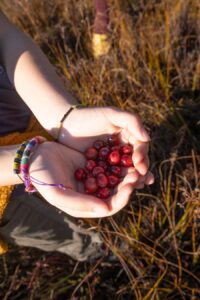There is something wonderfully primitive about foraging food. It feels like the way it should always be. There are no signs or sounds of civilization out in the dunes. Just coyote tracks along the paths.

Last year, some friends brought me on a family outing that we’re going to make an annual pre-Thanksgiving tradition — picking cranberries in the shady hollows of the Province Lands dunes. This year, a group of us gathered with our kids on an unseasonably warm Monday for an after-school adventure.

Remembering how water pools in the low marshy areas, the exact conditions cranberries require, I texted the other moms, “Don’t forget waterproof shoes.”

The air buzzed with the seven kids’ excitement and laughter. They rolled down the dunes and competed to pick the most cranberries. Our group is always looking for fun activities in nature to enjoy with our children. This one is particularly good: it’s both empowering for them and a good outlet for their energy as they climb and jump through the dunes. “They’ll sleep well tonight,” said Jenny Clarke, one of the mothers, as we trekked back.

Walking to our cars, we passed a dramatic line between the colors of the autumn forest and the sandy dunes. At the top of the hill, we paused to catch our breath and enjoy the wide view of dunes and sea, comparing notes on how we would use the day’s berry harvest.

Katie Emond was going to make cranberry bread that very night. Katie Driscoll planned to use them for a cranberry sauce for Thanksgiving dinner. “I just add sugar, orange zest, and that’s it,” she said.

Jenny Clarke’s plans were thwarted, however. Her baby scattered all the cranberries they had gathered. “I’ll have to go to the store and buy some,” she said. “I was looking forward to making cranberry kombucha.”
MYTHBUSTERS
No, Cranberry Farmers Don’t Put Wolf Spiders in Bogs
The image seems like something straight out of a Cape Cod-themed horror movie. You wade into a flooded cranberry bog, excited to make your first harvest, only to find yourself covered in dozens of wolf spiders skittering to escape the water. You scream, but the farmers tell you not to worry — they know about the spiders; in fact, the growers put the spiders there in the first place.
Except that’s not how it actually happens. The story of spiders being released as natural pest control by commercial cranberry growers, which spread like wildfire earlier this year thanks to social media, is a myth, according to Leo Cakounes, one of the owners of Cape Farm Supply and Cranberry Co. in Harwich.
“It’s not just a no, it’s a strong no,” Cakounes says. “You’ve got to be the hundredth person this year who’s asked me this.”
Cakounes says he brings in beehives to pollinate and sometimes releases ladybugs to prey on pests like aphids. But spiders? Absolutely not. “We have sheep and goats that eat the weeds for us,” he says. “Why don’t people ever ask about that?”
The normally dry bogs, which farmers fill with water for a few days each year to harvest the buoyant cranberries, are home to plenty of animals that find themselves displaced by the unexpected floods. Cakounes says he often sees mice, snakes, and other critters scrambling to escape the water, but he can’t imagine how the story ever escalated into a storm of social media misinformation focused solely on cranberry bog spiders.
“Please put this on the internet so people will stop asking,” he says. —Parker Mumford



